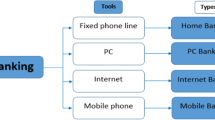Abstract
This paper focuses on credit card fraud in Multimedia Products, which are soft-products. By soft-products, we mean intangible products that can be used and consumed without having them shipped physically, such as software, music and calling cards (calling time). The demand for soft-products, mainly Multimedia Products, on the Internet has grown in the last few years and is rapidly increasing. Credit card fraudulent transactions on such products are very easy to conduct, while very difficult to recover, compared to the fraud cases in hard-products transactions. This paper classifies the types of products sold on the Internet, and the usual fraud occurred in each type. It summarizes some of the existing best practices to prevent credit card fraud. Finally, it introduces the use of a Trusted Email as a way to authenticate the customer and to simulate his/her physical address (since on these products no actual shipping will happen).
Similar content being viewed by others
References
E. Aleskerov, B. Freisleben, and B. Rao, “CARDWATCH: A neural network based database mining system for credit card fraud detection,” in Computational Intelligence for Financial Engineering (CIFEr), Proceedings of the IEEE/IAFE 1997, 1997, pp. 220–226.
R. Brause, T. Langsdorf, and M. Hepp, “Neural data mining for credit card fraud detection,” in Proceedings of 11th IEEE International Conference on Tools with Artificial Intelligence, 1999, pp. 103–106.
M. Bruno, “Microsoft gives boost to surrogate card numbers,” Bank Technology News, http://www. breakbanktechnews.com/btn/articles/btnoct01-1.shtml
P. K. Chan, W. Fan, A. L. Prodromidis, and S. J. Stolfo, “Distributed data mining in credit card fraud detection,” IEEE Intelligent Systems14(6), November–December 1999, pp. 67–74.
M. Duvall, “Consortium to facilitate Internet payments,” Interactive Week, September 24, 2001, 26.
S. Ghosh and D. L. Reilly, “Credit card fraud detection with a neural-network,” in Proceedings of the Twenty-Seventh Hawaii International Conference on Information Systems: Decision Support and Knowledge-Based Systems, System Sciences, Vol. 8, 1994, pp. 621–630.
V. Hanagandi, A. Dhar, and K. Buescher, “Density-based clustering and radial basis function modeling to generate credit card fraud scores,” in Proceedings of the IEEE/IAFE 1996 Conference on Computational Intelligence for Financial Engineering, 1996, pp. 247–251.
Ch. T. Heun, “Fear of fraud,” Information Week.com, March 4, 2002, http://www.information-week. com/story/IWK20020301S0002
Vantage Card Services Inc., Prevent chargebacks, http://www.vantagecard.com/html/ preventchargebacks.html
Yahoo, Merchant operating procedures guide, http://sg.store.yahoo.com/mopg.html
Author information
Authors and Affiliations
Rights and permissions
About this article
Cite this article
Alfuraih, S.I., Sui (Alsawi), N.T. & McLeod, D. Using Trusted Email to Prevent Credit Card Frauds in Multimedia Products. World Wide Web 5, 245–256 (2002). https://doi.org/10.1023/A:1020940830716
Issue Date:
DOI: https://doi.org/10.1023/A:1020940830716




